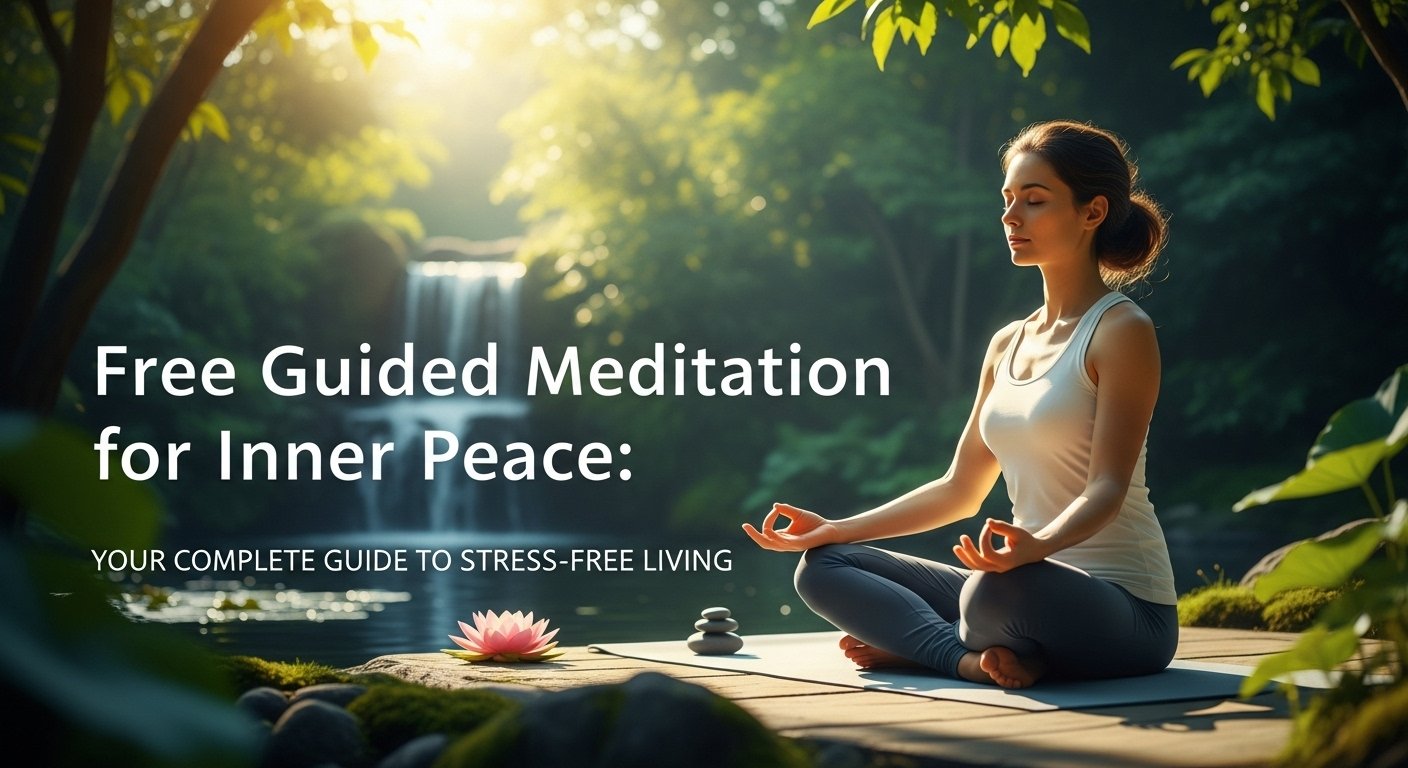In our bustling modern world, finding moments of calm can feel impossible. Between work deadlines, family responsibilities, and endless notifications, your mind rarely gets a break. But what if there was a simple, free way to find inner peace anywhere, anytime?
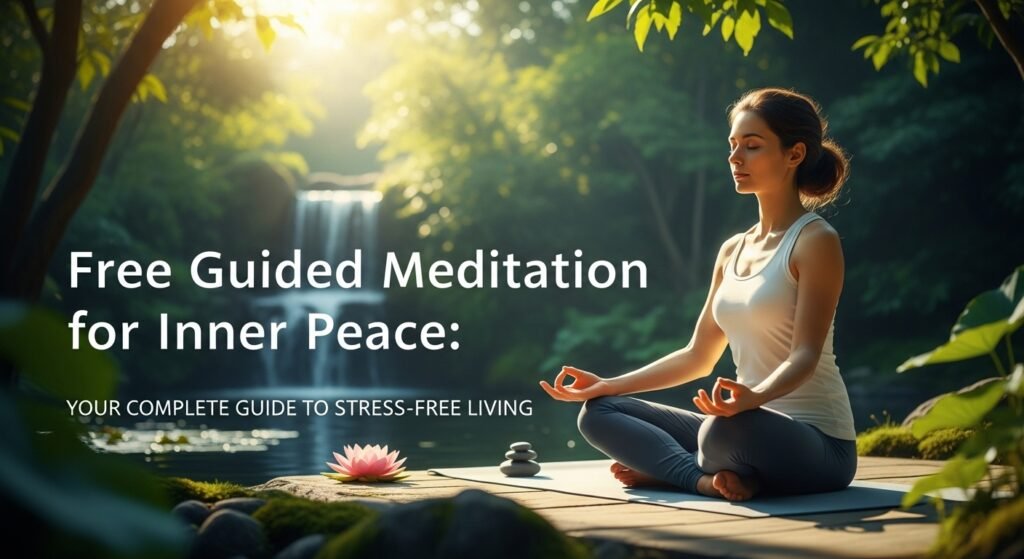
Free guided meditation offers exactly that—a pathway to tranquility that requires nothing more than a few minutes of your day and a willingness to listen. Whether you’re dealing with anxiety, stress, or simply seeking a deeper sense of well-being, guided meditation can transform your mental landscape without costing you a penny.
This comprehensive guide will walk you through everything you need to know about free guided meditation for inner peace, from understanding its profound benefits to discovering the best resources available online.
What Is Guided Meditation?
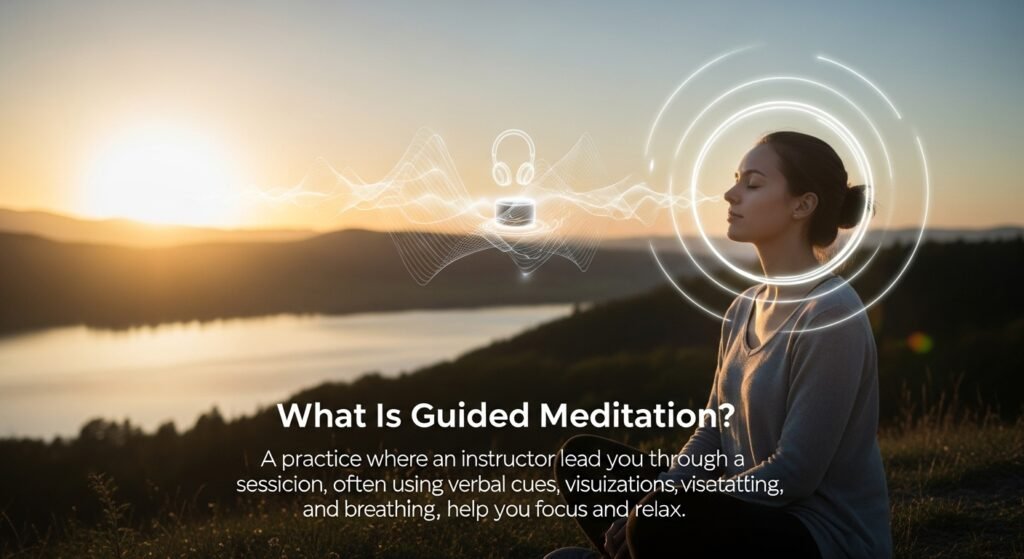
Guided meditation is a form of mindfulness practice where an instructor leads you through the meditation process using spoken cues. Unlike silent meditation, where you sit alone with your thoughts, guided sessions provide gentle direction, helping you focus your attention and navigate the meditation journey.
During a guided meditation session, you’ll typically hear:
- Breathing instructions
- Body awareness cues
- Visualization exercises
- Positive affirmations
- Gentle reminders to refocus when your mind wanders
This supportive approach makes meditation accessible to beginners while providing structure that even experienced meditators find valuable.
The Science Behind Guided Meditation and Inner Peace
Research consistently shows that guided meditation creates measurable changes in both brain structure and function. Studies from Harvard Medical School reveal that regular meditation practice can actually reshape your brain, increasing gray matter in areas associated with emotional regulation and decreasing activity in the amygdala—your brain’s stress center.
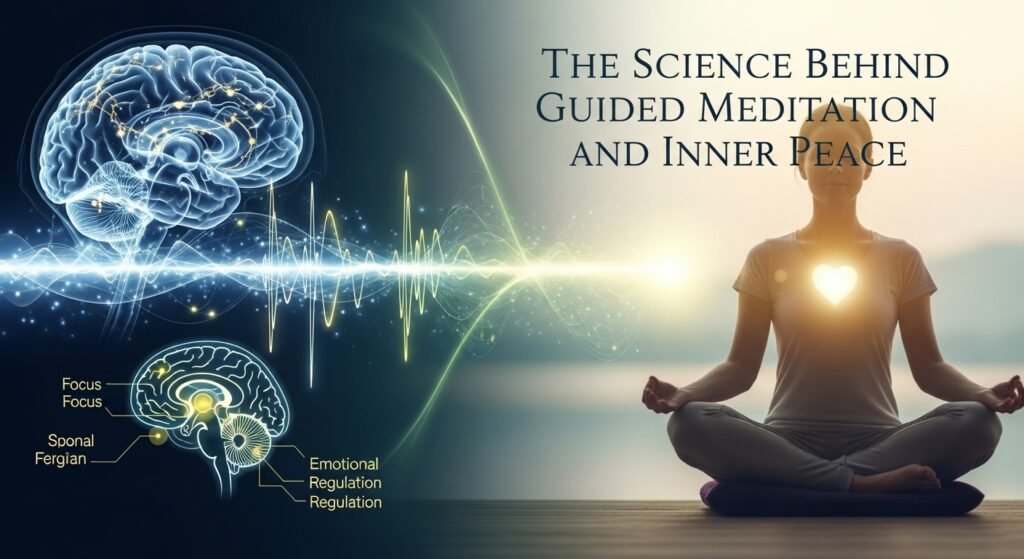
When you practice guided meditation regularly, your nervous system learns to shift from the “fight or flight” response to the “rest and digest” state. This biological change helps you:
- Process stress more effectively
- Respond rather than react to challenging situations
- Maintain emotional balance throughout the day
- Experience deeper, more restorative sleep
The guided aspect is particularly powerful because it provides external anchors for your attention, making it easier to enter meditative states and experience their benefits.
8 Powerful Benefits of Free Guided Meditation
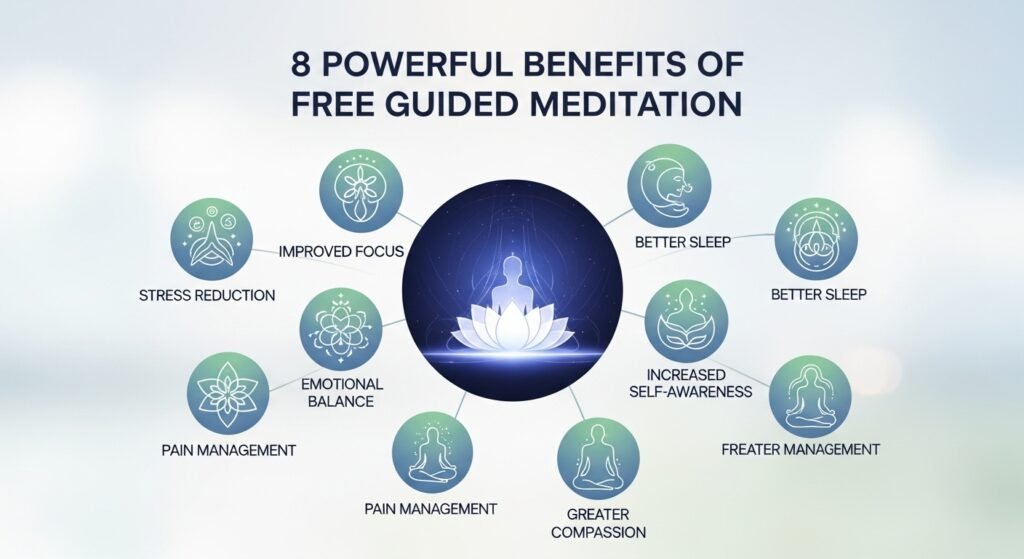
1. Stress and Anxiety Reduction
Guided meditation for stress and anxiety works by activating your body’s relaxation response. As you follow the instructor’s voice, your heart rate slows, blood pressure decreases, and stress hormones like cortisol drop to healthier levels. Many people notice reduced anxiety symptoms after just a few sessions.
2. Improved Sleep Quality
Evening guided meditations can significantly enhance sleep quality by helping your mind transition from the day’s activities to rest mode. Sleep-focused guided sessions often include progressive muscle relaxation and gentle breathing techniques that prepare your body for deep, restorative sleep.
3. Enhanced Emotional Regulation

Regular practice helps you develop greater emotional awareness and control. Instead of being swept away by intense feelings, guided meditation teaches you to observe emotions with curiosity rather than judgment, creating space between triggers and responses.
4. Increased Focus and Concentration
Guided mindfulness meditation trains your attention like a muscle. The practice of repeatedly returning focus to the instructor’s voice or specific focal points strengthens your ability to concentrate in all areas of life.
5. Lower Blood Pressure
Multiple studies show that meditation can reduce both systolic and diastolic blood pressure. The deep relaxation achieved through guided practice helps relax blood vessels and reduce the cardiovascular strain associated with chronic stress.
6. Pain Management

Guided meditation can alter your relationship with physical discomfort. By learning to observe sensations without resistance, many people experience reduced pain intensity and improved coping strategies for chronic conditions.
7. Boosted Immune Function
Research indicates that regular meditation practice strengthens immune system function by reducing inflammation and stress-related immune suppression. This means fewer colds, faster healing, and better overall health resilience.
8. Greater Self-Awareness
Perhaps most importantly, guided meditation cultivates deeper self-understanding. As you learn to observe your thoughts and patterns without judgment, you develop greater insight into your motivations, fears, and authentic desires.
How to Practice Guided Meditation for Inner Peace
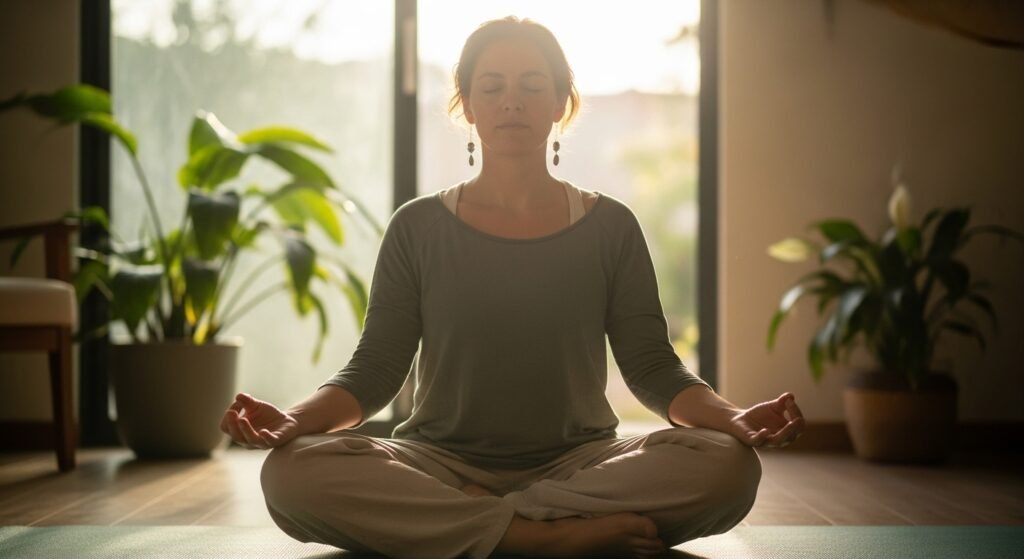
Setting Up Your Space
Creating the right environment enhances your meditation experience:
Choose a quiet location where you won’t be interrupted. This doesn’t need to be a special room—a corner of your bedroom or living room works perfectly.
Minimize distractions by turning off notifications, closing doors, and letting family members know you need a few minutes of quiet time.
Get comfortable using a cushion, chair, or even lying down if that feels best. The key is maintaining alertness while being physically at ease.
Dim the lights or close your eyes completely to reduce visual stimulation and help your mind turn inward.
Basic Technique for Beginners
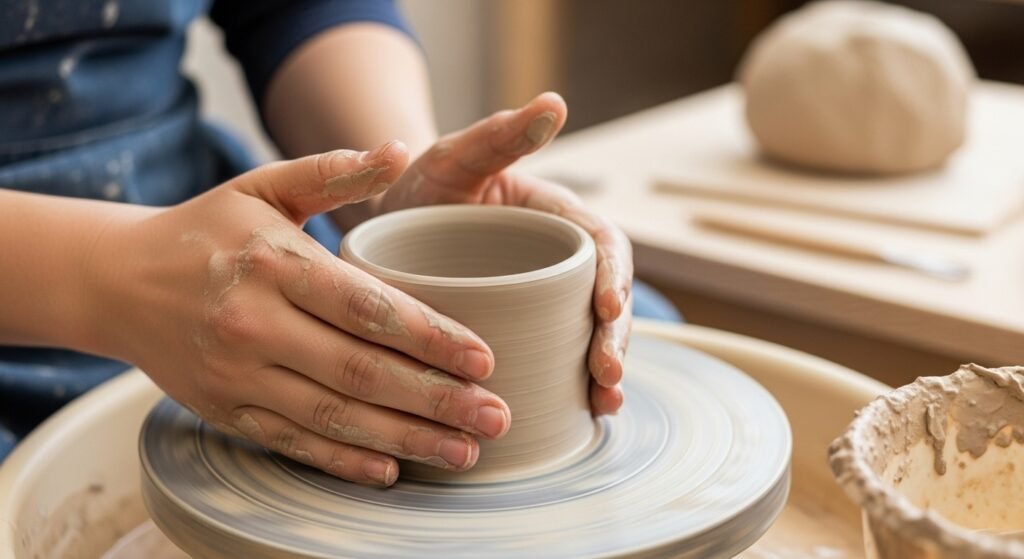
Starting your guided meditation practice is simpler than you might think:
- Find a 5-10 minute guided session online (we’ll share resources below)
- Sit or lie comfortably with your spine naturally straight
- Close your eyes and take three deep breaths to settle in
- Press play and simply follow the instructor’s voice
- Don’t worry about “doing it right”—there’s no perfect way to meditate
- When your mind wanders (and it will), gently return attention to the guide’s voice
Advanced Techniques
Once you’re comfortable with basic guided meditation, you can explore more specific approaches:
Body scan meditations systematically relax each part of your body, releasing physical tension while calming mental chatter.
Loving-kindness practices cultivate compassion and emotional healing by directing well-wishes toward yourself and others.
Visualization meditations use mental imagery to create peaceful states and rehearse positive outcomes.
Breathing-focused sessions use various breath patterns to activate different aspects of your nervous system.
Best Free Guided Meditation Resources
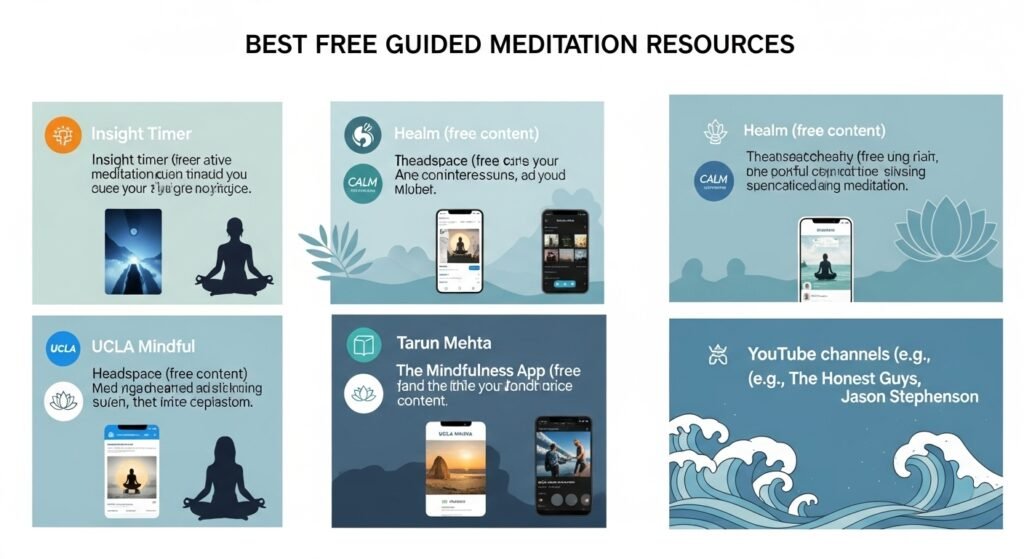
Top Apps for Free Guided Meditation
Insight Timer
This app offers the largest free library of guided meditations, with over 100,000 sessions from teachers worldwide. You’ll find content for every experience level and interest, from 3-minute breathing exercises to hour-long deep relaxation sessions.
Headspace (Free Version)
While Headspace requires a subscription for full access, the free version includes foundational meditations perfect for beginners. The animations and clear instructions make it particularly user-friendly.
Calm (Free Content)
Calm’s free tier includes daily meditations, breathing exercises, and some of their famous sleep stories. The production quality is exceptional, making it easy to focus and relax.
UCLA Mindful
Created by UCLA’s Mindful Awareness Research Center, this app offers scientifically-backed meditations completely free. The sessions focus on evidence-based techniques proven to reduce stress and improve well-being.
YouTube Channels for Guided Meditation
The Honest Guys
Known for high-quality audio and diverse content, The Honest Guys offer meditations ranging from 10 minutes to several hours. Their nature-based visualizations are particularly effective for stress relief.
Jason Stephenson
Specializing in sleep meditations and anxiety relief, Jason’s soothing Australian accent has helped millions find peace. His channel includes specific sessions for different needs, from self-confidence to pain relief.
Michelle’s Sanctuary
Offering a mix of guided meditations, affirmations, and sleep stories, Michelle’s Sanctuary provides gentle, nurturing content perfect for beginners and sensitive individuals.
Great Meditation
This channel focuses on Buddhist-inspired meditations with clear instructions and minimal distractions. The content is ideal for those seeking deeper spiritual connection alongside stress relief.
Websites and Podcasts
Palouse Mindfulness
This website offers a complete 8-week mindfulness-based stress reduction (MBSR) course for free, including guided meditations, handouts, and video presentations.
Dharma Ocean
Providing free dharma talks and guided meditations rooted in Buddhist wisdom, this resource offers profound teachings alongside practical techniques.
Ten Percent Happier (Free Content)
While primarily a paid service, Ten Percent Happier offers free meditations and podcasts featuring conversations with meditation teachers and scientists.
Creating Your Daily Practice
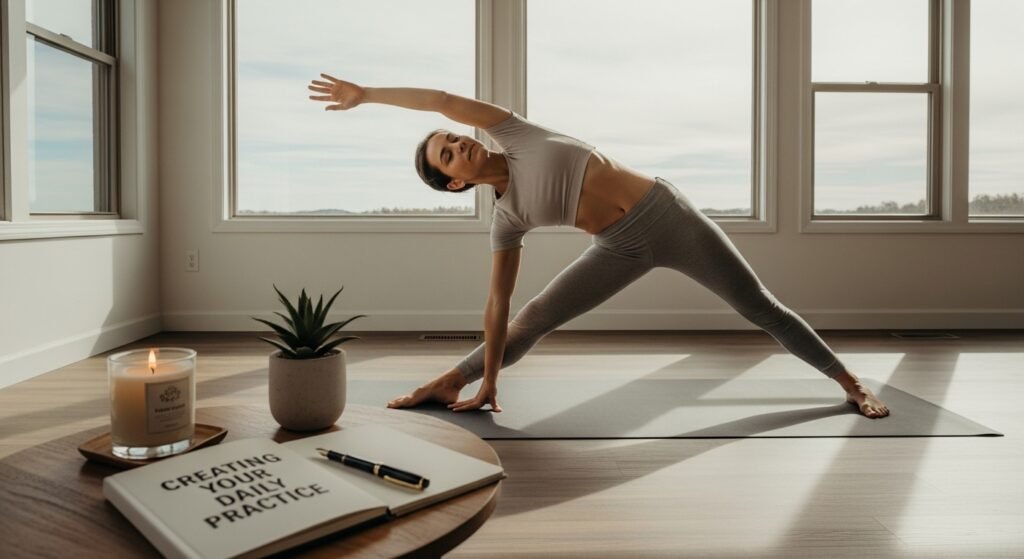
Start Small and Build Gradually
The biggest mistake beginners make is trying to meditate for too long too soon. Start with just 5-10 minutes daily and gradually increase as the practice becomes more comfortable. Consistency matters more than duration.
Choose a Regular Time
Establishing a consistent schedule helps meditation become a natural habit. Many people find success with:
- Morning meditation to set a peaceful tone for the day
- Lunch break sessions to reset and recharge
- Evening practice to release the day’s stress and prepare for sleep
Track Your Progress
Keep a simple meditation journal noting:
- How long you meditated
- Which guided session you used
- How you felt before and after
- Any insights or challenges that arose
This awareness helps you identify what works best and stay motivated during difficult periods.
Be Patient with Yourself
Some days meditation will feel effortless and blissful. Other days, your mind might feel chaotic and restless. Both experiences are normal and valuable. The goal isn’t to achieve a particular state but to develop greater awareness and acceptance of whatever arises.
Overcoming Common Challenges

“I Can’t Stop Thinking”
This is the most common meditation myth. The goal isn’t to stop thoughts but to notice them without getting caught up in their stories. When you realize you’ve been thinking, gently return attention to your breath or the guide’s voice. Each time you notice and return is a moment of successful meditation.
“I Don’t Have Time”
Even three minutes of guided meditation can create noticeable benefits. Consider meditation not as another task on your to-do list but as an investment that makes everything else more manageable and enjoyable.
“I Feel Worse After Meditating”
Sometimes meditation brings suppressed emotions to the surface, which can initially feel uncomfortable. This is actually a sign that the practice is working—you’re developing the courage to face rather than avoid difficult feelings. If persistent distress occurs, consider working with a qualified teacher or therapist.
“I Keep Falling Asleep”
If you consistently fall asleep during meditation, you might be sleep-deprived or meditating in too comfortable a position. Try sitting upright, opening your eyes slightly, or choosing a more energizing guided session.
Making Guided Meditation Part of Your Lifestyle
Micro-Meditations for Busy Days
When you can’t find time for full sessions, try mini-meditations:
- Three conscious breaths before starting your car
- One minute of body awareness while waiting in line
- Brief loving-kindness phrases during your commute
- Mindful breathing during commercial breaks
Sharing the Practice
Consider introducing family members or friends to guided meditation. Group practice can strengthen relationships while providing mutual support and accountability.
Seasonal and Situational Adaptations
Different life circumstances call for different meditation approaches:
- Holiday stress: Focus on gratitude and acceptance practices
- Work pressure: Use quick anxiety-relief sessions
- Relationship challenges: Emphasize loving-kindness and forgiveness meditations
- Health concerns: Explore healing visualizations and pain management techniques
The Long-Term Journey to Inner Peace
Free guided meditation offers an accessible doorway to lasting inner peace, but remember that meditation is a practice, not a destination. Some days will feel transformative, others challenging. Both contribute to your growth and understanding.
As you continue exploring guided meditation, you’ll likely discover particular teachers, styles, and approaches that resonate most deeply with you. Trust this natural selection process—your intuition knows what you need for healing and growth.
The beauty of free guided meditation lies not just in its accessibility but in its infinite variety. Whether you have three minutes or an hour, whether you’re seeking stress relief or spiritual connection, there’s a guided meditation waiting to meet you exactly where you are.
Start today, start small, and trust the process. Your future self—calmer, more centered, and deeply at peace—is waiting on the other side of that first conscious breath.
Remember, the path to inner peace isn’t about perfection; it’s about presence. Every moment you choose awareness over unconsciousness, every time you return to your breath, every guided meditation you complete is a step toward the peaceful, balanced life you deserve.
Your inner peace awaits. All you need to do is press play.
